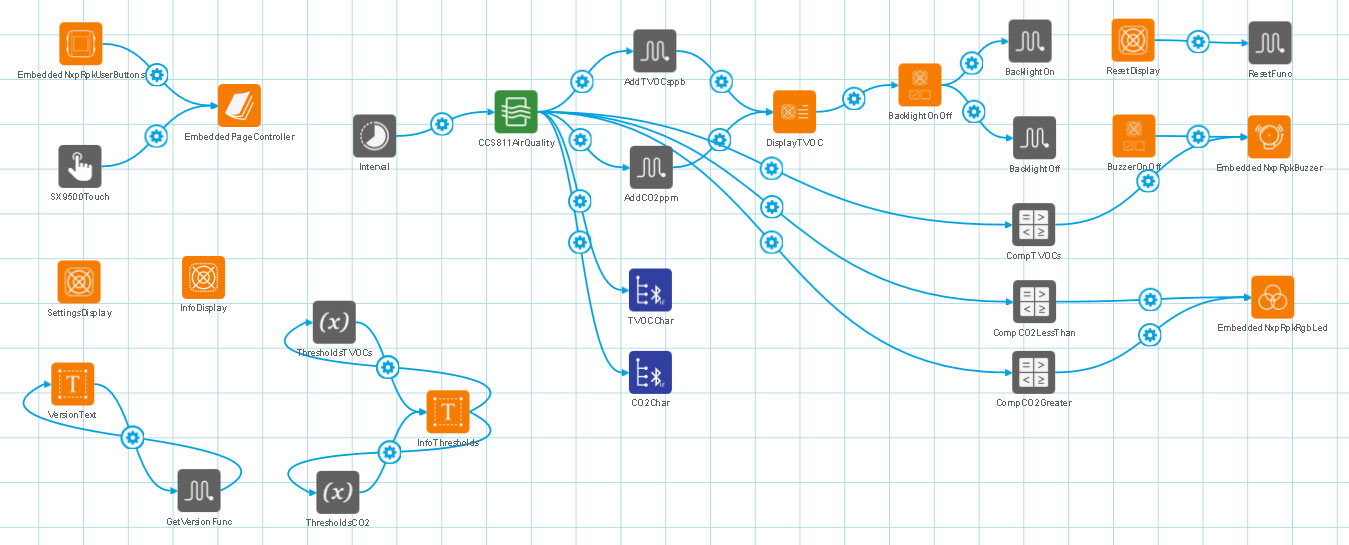Good indoor air quality is very important for our health and well-being.
Two big indicators of air quality are: Volatile Organic Compounds (or VOCs) and CO2 concentration.
Volatile Organic Compounds (VOCs) are a large group of chemicals that are found in many products we use in our daily lives.
Repeated or long-term exposure to VOCs can have harmful health effects and may increase some people’s risk of developing certain types of diseases (ex. cancer) and health problems.
Over years of exposure, even very small amounts of these - in concentrations that produce no acute symptoms - can put people in danger.
The health effects of contamination often happen over decades.
The main Volatile Organic Compounds (VOCs) are:
- Formaldehyde
- Ethylbenzene
- Benzene
- Styrene
- Perchloroethylene
- Methyl tert-butyl ether
- Xylene
- Toluene
- Methylene chloride
- …
Studies have shown that the level of VOCs indoors is generally higher than the level of VOCs outdoors. Concentrations of VOCs are often up to 10 times higher indoors than they are outdoors.
Since we spend most of our time indoors, we should take special care in decreasing the amount of VOCs emitted in the indoor environment.
Indoor air quality can be improved by controlling the sources of VOCs emissions.
VOCs can be released into indoor air from a variety of sources, produced and used in our daily lives. These include and are not limited to the following: cigarette smoke, indoor combustion sources, vehicle exhaust, emissions from office equipment (copying and printing machines), furnishings, and various building materials such as paints, varnishes, glues and solvents.
VOCs can also come from personal care products such as perfumes, deodorants, soaps, shampoos, lotions, hair sprays, cosmetics; household products, cleaning supplies, disinfectants, laundry detergents, fabric softeners, dish detergents and even air fresheners.
Another important factor and indicator of indoor air quality is the concentration of carbon dioxide (CO2).
Carbon dioxide is a chemical compound composed of one atom of carbon and two atoms of oxygen. Its chemical formula is CO2.
The amount of CO2 in a given air sample is commonly expressed as parts per million (ppm).
Carbon dioxide is a natural component of air, but in high concentrations it may cause some problems.
Among other things, it is produced by human respiration. As a result, its concentration in indoor air inevitably increases over time, and what's more, it raises in proportion to the number of people in a given-size room: when several people stay in a room for a long period of time, the concentration of CO2 increases rapidly and leads to poor indoor air quality.
People who spend hours and hours in rooms with poor air quality and excessive CO2 concentrations will show symptoms such as: fatigue, drowsiness, headaches, dizziness, sensations of breathing difficulty, lack of concentration, loss of attention.
High indoor levels of carbon dioxide may negatively affect our memory, our ability to think at full potential; it could affect performance in the workplace, learning ability of students at school and decrease people’s productivity.
At extremely high levels (at 100, 000 parts per million, for instance) it can cause loss of consciousness and at even higher levels it can lead to death.
Places, such as schools, crowded classrooms, libraries, meeting rooms, or even gyms are increasingly being recognized as indoor environments with elevated CO2 leading to poorer performance.
High levels of carbon dioxide often indicate inadequate or improper ventilation and the need to get fresh air from outside by opening the window and let in fresh air into the room.
It follows that it is essential to monitor indoor air quality to maintain healthy conditions indoors and to create an appropriate environment for living or working.
NXP's Rapid IoT Prototyping Kit for indoor air quality monitoringIn order to monitor the levels of VOCs and the concentration of CO2 in indoor air, we use NXP's Rapid IoT Prototyping Kit.
A digital gas sensor for indoor air quality monitoring CCS811 is inside the Rapid IoT Prototyping Kit.
The CCS811 is an ultra-low power digital gas sensor solution which integrates a metal oxide (MOX) gas sensor to detect CO2 levels and a wide range of Volatile Organic Compounds (VOCs) for indoor air quality monitoring with a microcontroller unit (MCU), which includes an Analog-to-Digital converter (ADC), and an I²C interface.
CCS811 supports intelligent algorithms to process raw sensor measurements to output equivalent total VOC (eTVOC) and equivalent CO2 (eCO2) values.
The equivalent Total Volatile Organic Compound (eTVOC) output range for CCS811 is from 0 ppb up to 32768 ppb.
The equivalent CO2 (eCO2) output range for CCS811 is from 400 ppm up to 32768 ppm.
This sensor can be mainly used for indoor air quality monitoring in:
- Smart phones;
- Air cleaners and purifiers;
- Smart thermostats;
- Home controllers;
- Smart accessories and IoT devices.
NXP’s Rapid IoT Prototyping Kit along with Rapid IoT Studio by Atmosphere will allow us to build and develop our IoT application in a very easy, simple and fast way.
In the following picture you can see the schematic of the connections among the elements in the NXP's Rapid IoT Prototyping Kit.
The application for the Rapid IoT Prototyping Kit consists of the following pages:
- The main page that shows TVOCs and CO2 values. By clicking the bottom-right push button you turn on the backlight; if you press the bottom-left push button you turn the backlight off. The bottom touch button allows you to move to the Settings page.
- The Settings page: the top touch button allows you to go back to the previous page; if you press the right touch button, you go to the Info page and if you press the bottom touch button, you go to the Thresholds page.
- The Info page: the left touch button allows you to return to the Settings page; if you press the bottom touch button, on the screen you will display the application info.
- The Thresholds page: the top touch button lets you return to the Settings page; if you press the right touch button, you go to the Backlight page; if you press the top-right push button, the TVOCs threshold will appear on the screen; if you press the bottom-right push button, the CO2 threshold will be displayed.
When the TVOCs threshold is exceeded, the device will emit some warning beeps. When the CO2 threshold is exceeded, the device will set red led on; whereas if the CO2 level is optimal the device will toggle green led.
- The Backlight page: you can turn on and off the backlight by pressing the bottom-left push button; the right touch button allows you to go to the Buzzer page and the left touch button to go back to the Thresholds page.
- The Buzzer page: you can turn on and off the buzzer by pressing the bottom-left push button; by clicking the right touch button you will go to the Reset page and by clicking the left touch button you will go back to the Backlight page.
- The Reset page: you can reset the device Rapid IoT Prototyping Kit by pressing the bottom-left push button; the left touch button will allow you to return to the Buzzer page.
Here following you can find the schematic of the connections among the elements for Smartphoneapp.
Data read through Bluetooth are sent to the cloud and displayed on your Smartphone in the form of values.
In the image below you can find the schematic of the connections among the elements for the Cloud.
Data received through the app are stored and can be displayed on two timing diagrams: one for TVOCs and the other for CO2, as you can see in the following picture.
In order to make the device wearable, I have added a clip on the back of the Rapid IoT Prototyping Kit. The clip is attached to the device through two M2 x 6mm bolts. See the following pictures.
Here enclosed you can find the complete project for Rapid IoT Studio and the stl file for the clip.











Comments
Please log in or sign up to comment.